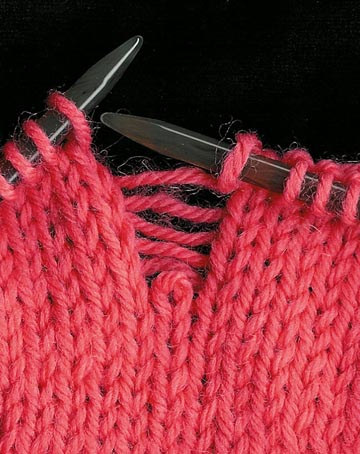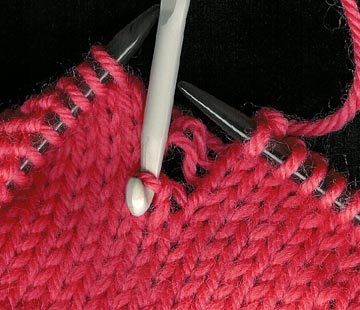10:
Dropped Stitches
(cont.)
Sometimes, the dropped stitch travels down a few rows, and
you will have a little ladder of connecting threads [pic 13].

13: A vertical row of dropped stitches is like a ladder.
Whether the stitch is one or several rows down, the repair is
done in the same way. Pick up the stitches in turn until you reach
the top of the ladder, making sure to re-insert the needle from the
front to the back each time you pick up a stitch, because the new
stitch is twisted when you pull the connecting thread through.
If you find this difficult to do with a needle point, use a crochet
hook. It is much easier to hook the threads through the stitches
(but first you have to find a crochet hook!) [pic 14].

14: You may prefer to use a crochet hook rather than a
needle. It is really much easier to use, as a stitch tends to slip
off a needle.If the row is a purl
row, you can reestablish the stitch from the purl side, using either
a crochet hook or a spare needle, but it is much easier to work from
the knit side of the work.
When you get the stitch back on to the needle, make sure that it is
twisted the same way as the stitches already on the needle.
If you are unconfident about fixing dropped stitches, knit a square
to try the different techniques and you will be surprised at how
easily you can pick up stitches. Youíll soon be an expert!
---
Split stitches
Sometimes you may notice a stitch some rows down that is twisted
or split. It is worthwhile fixing this stitch. This time you drop a
stitch on purpose. Knit to the stitch above and to the right of the
stitch you want to fix. Drop the stitch above the problem stitch off
the needle, and then gently pull the knitting to make a ladder. Stop
just below the problem stitch, and then one by one, pick up the
stitches until you reach the top again. The stitches may look a bit
messy or uneven, but if you gently scratch the back of the work with
the tip of your finger, you should be able to ease the loops back
into shape.
---
Patterned stitches
I donít want to alarm you, but when it comes
to pattern stitches, things can be very difficult. If you understand
the construction, you should be able to re-establish a dropped
stitch as, after all, pattern stitches are mainly just a combination
of knit and purl stitches, but sometimes the dropped stitch does get
lost. And whatever you try to do, the pattern design is wrecked.
Then itís a case for un-knitting or ripping the whole lot off the
needles and undoing a few rows. Or start something else.
---
Extra stitches
The opposite problem to dropped stitches is
extra stitches. This happens when, by mistake, you pick up a stitch
by putting the needle under the connecting thread between two
stitches and make another stitch. This is really easy to do when you
are working with fancy, furry, hairy or knobbly yarns. When you are
counting, you will notice that you have extra stitches, or the
knitting is wider than the start. Hold the knitting to the light and
you will see where the mistake has occurred. The extra stitch will
show as a hole and you will see that a new vertical sequence of
stitches has started at that point. It would be nice if you could
just drop that stitch down, but you will be left with a ladder of
connecting threads. Iím sorry to have to tell you that you just have
to undo all the knitting back to where the number is right.
---
Make sure that you donít split the yarn as
you pick up the stitches. It is easy to do with all that playing
around, and may show up later when you are ironing the garment.
Good luck!
NEXT
CHAPTER >>
chapter page: 1 |
2 | 3 |
4 | 5 |